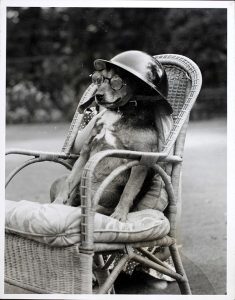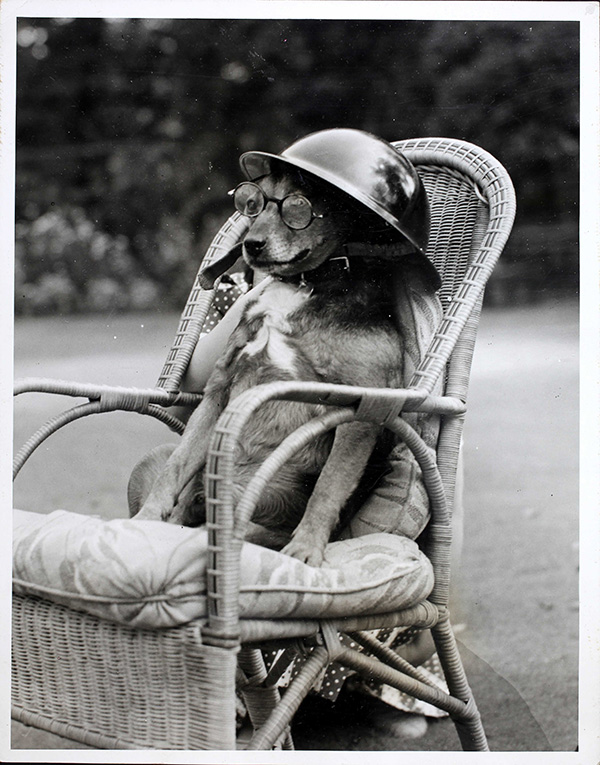Pets in World War Two.
Operation Dynamo, the ‘Miracle of Dunkirk’ was the orderly evacuation of over 300,000 Allied troops from occupied Europe. A little-known part of this piece of history is that many pets were adopted by British troops and also made the exodus too. On the journey through Belgium to an embattled pocket on the north-east coast of France, during May 1940, soldiers witnessed dogs running about, lost, looking for their owners. Some were hungry and getting snappy. Young soldiers took pity on these poor animals and many dogs attached themselves to the retreating British armies and during the evacuation made it to the beach where the Royal Navy destroyers came to rescue troops. According to an article in the Telegraph, the animals were amazingly scrambling into the sea and onto the rescuing ships – the RSPCA’s post war history stated: “knowing with the sureness of canine instinct that the men who had so far befriended them in their appalling need would not desert them at the last”.
The RSPCA also recorded: “All along the Thames Estuary and the south and south-east coast where the little ships of all kinds landed wearied men, equally wearied and homeless dogs were also brought ashore. ‘Our Dumb Friends’ League’ (the animal welfare charity, founded in 1897) in a 1940 report said: “What was to happen to these dogs? The answer was destruction or outside help. When asked by the Ministry of Agriculture for help, the League came back at once. We will take them! Send them to us at once! So the League has or had 107 dogs in quarantine.” As a nation Britain is well known for loving animals so this story, albeit not well known, is not that surprising. But contrasting against this is another little-known story involving pets and WWII.
This one, however, is perhaps a little more shocking and involves the massive cull of pets in Britain at the start of the Second World War. This widely ignored tragedy of war story has been recently raked up in a new book called: ‘Bonzo’s War: Animals Under Fire 1939 -1945’, and subsequently the BBC have recently reported on the shocking statistic that an estimated 750,000 pets were destroyed in the first week of the war. The cull apparently was believed to be a humane alternative to having beloved pets terrified and roaming the streets among the carnage of war.
A government pamphlet as part of a public information campaign fuelled anxiety among many of the British public, who assumed that putting pets down was the right thing to do for the country. During the Munich Crisis in 1939, when Germany had occupied parts of Czechoslovakia, animal charities had apparently been overrun by calls from pet owners who were worried that their pets would become contaminated by mustard gas or hysterical at the sound of sirens and explosions, and run wild through the streets.

On the eve of the war, the National Air Raid Precautions Animals Committee (NARPAC) was formed and a pamphlet was published and said: “If at all possible, send or take your household animals into the country in advance of an emergency.” It concluded: “If you cannot place them in the care of neighbours, it really is kindest to have them destroyed.” The advice was printed in almost every newspaper and when Hitler invaded Poland, a BBC broadcast confirmed it was official policy that pets would not be given shelter. The result was widespread panic. Historian Hilda Kean says that it was just another way of signifying that war had begun. “It was one of things people had to do when the news came – evacuate the children, put up the blackout curtains, kill the cat.” Apparently it was the lack of food, not bombs, that posed the biggest threat to wartime pets. There was no food ration for cats and dogs. “People were basically told to kill their pets and they did. They killed 750,000 of them in the space of a week – it was a real tragedy, a complete disaster,” said Clare Campbell, author of the new book.
Campbell remembers a story about her uncle. “Shortly after the invasion of Poland, it was announced on the radio that there might be a shortage of food. My uncle announced that the family pet Paddy would have to be destroyed the next day.” After war was declared on 3 September 1939, pet owners thronged to vets’ surgeries and animal homes. “Animal charities, the PDSA, the RSPCA and vets were all opposed to the killing of pets and very concerned about people just dumping animals on their doorsteps at the start of the war,” says historian Hilda Kean. Battersea Dogs and Cats Home had just four staff but the home managed to feed and care for 145,000 dogs during the course of the war. It opened its doors in 1860 and survived both wars. “People were worried about the threat of bombing and food shortages, and felt it inappropriate to have the ‘luxury’ of a pet during wartime,” explains Pip Dodd, senior curator at the National Army Museum.
How do you feel about this story? What would you have done? Given all the horrors and human suffering that followed over the six years of the war, do you think it is understandable that the cull of pets is not widely publicised? Historian Kean says: “The story is not more widely known because it was a difficult story to tell”. “It isn’t well known that so many pets were killed because it isn’t a nice story, it doesn’t fit with this notion of us as a nation of animal lovers. People don’t like to remember that at the first sign of war we went out to kill the pussycat,” she told the BBC.. “The Royal Army Veterinary Corps and the RSPCA tried to stop this, particularly as dogs were needed for the war effort.”
Dogs played a part in WWII and WWI if you read our previous blog about dogs in the trenches. Many contributed to the war effort and won the Dickin Medal, for their heroic service during war. The award is commonly referred to as ‘the animals’ Victoria Cross‘.
Do you have any stories of animals and war?
Perhaps there have been stories passed down through your family from your military ancestors about courageous animals that played a part during war. In our ‘historic documents library we have an article from The War Illustrated in our records that records that records the sad news about 1,000,000 pets destroyed during WWII. Maybe you could find out more about your family’s military history – visit Forces War Records and search our vast collection of records.


